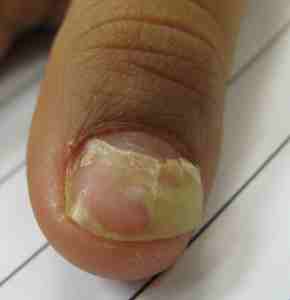

MedFriendly®


Onychomadesis
Onychomadesis is complete, periodic, and spontaneous
shedding of the fingernails or toenails. The nail becomes
weak and brittle and the shedding begins towards the
bottom of the nail. It can be caused when the nail matrix
stops functioning temporarily. The nail matrix is the layer
of cells at the bottom of a fingernail or toenail.
Onychomadesis is usually associated with a number of
diseases that affect most of the body. Adults are more
likely to develop the condition than children. In children,
one known cause is hand foot and mouth disease, which
is a type of viral syndrome that often presents with a
rash on the hands, feet, and mouth.
FEATURED BOOK: The Permanent Pain Cure for Joint Pain
A fungal infection of the nails can also cause onychomadesis because nails are dead
tissue and fungi feed off of dead tissue. Fungi also thrive in warm and most areas. Thus,
people who frequently have moist skin, wear gloves often, and/or wear closed in shoes
and/or socks often, are more prone to developing fungal infections that can lead to
onychomadesis. Because people usually keep their feet covered more than their hands,
the toenails are more likely to be warm and moist and are thus more prone to developing
onychomadesis.
Typically, the group of fungi responsible for onychomadesis is Trichophyton, such as the
members Trichophyton rubrum and Trichophyton tonsurans. This group of fungi is known
for causing various skin infections.
"Where Medical Information is Easy to Understand"™
Infections can spread from infected instruments used for manicures
and pedicures or from coming into contact with fungi in public places
such as public showers, gyms, and pools. The type of fungus
causing onychomadesis can be determined by the doctor scraping
the nail and sending it for testing it under the microscope. Antifungal
medications such as Lamisil (Terbinafine), Diflucan (Fluconazole),
and Griseofulvin can be used to treat fungal infections of the nails to
prevent the nails from falling off. However, this does not prevent the
condition from recurring. The toenails are usually treated longer than
the fingernails (2 to 3 months) because the toenail fungal infection
tends to be worse.
Other causes of onychomadesis include trauma to the nails or skin, problems with the body’s immune
system (defense system), damage to small blood vessels, medication side effect, diabetes mellitus, and
reduced levels of estrogen (a type of hormone predominantly found in women), the latter of which can
make elderly women more prone to this condition because it increases infection risk. Diabetes mellitus is
a complex, long-term disorder in which the body is not able to effectively use a natural chemical called
insulin. Insulin's main job is to quickly absorb glucose (a type of sugar) from the blood into cells for their
energy needs and into the fat and liver cells for storage.
Nails undergoing onychomadesis typically appear dull, with white or yellow streaks on the sides.
Onychomadesis generally improves without any complications. In other words, the nail(s) grow back
without any other associated difficulties. Onychomadesis comes from the Greek word "onyx" meaning
"nail," and the Greek word "madesis" meaning "a growing bald." Put the words together and you have "a
growing bald (of) nails."















